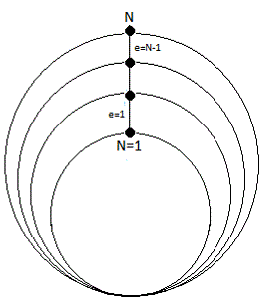Solution of the Rayleigh-Plesset Equation Through the Finite Element Method
Main Article Content
Keywords
cavitation, Rayleigh-Plesset equation, Galerkin´s finite element method, vapor pressure, inviscid fluid, incompressible fluid.
Abstract
In this work we present numerical solutions of the Rayleigh-Plesset equation which describes the evolution of cavitating bubbles. In order to do that, we consider FEMG (Finite Element Method Galerkin); this simulation is performed for an inviscid and incompressible fluid in an uniform temperature field with constant surface tension, and the cavitation model into the which the pressure inside bubbles is equal to the fluid vapor pressure. Thus, in this problem is considered the Dirichlet boundary problem, and we obtained criteria for the boundary conditions at the cavitation phenomenon through to the which give rise to the bubble growing.
PACS: 47.11.Fg, 47,55,db, 47.55.dd
MSC: 76T10, 76B10, 76M10
Downloads
References
[2] C. Tropea and A. Yarin, Springer Handbook of Experimental Fluid Mechanics. Würzburg: Springer, 2007. 148
[3] N. Berchiche, J.-P. Franc, and J.-M. Michel, “A cavitation erosion model for ductile materials,” J. Fluids Eng., vol. 124, no. 3, pp. 601–606, 2002. 148
[4] J. Hundemer and M. Abdel-Maksoud, “Prediction of tip vortex cavitation inception on marine propellers at an early design stage,” in 7th International Symposium on Cavitation, Michigan-USA, 2009, pp. 870–876. 148
[5] A. Philliph and W. Lauterborn, “Cavitation erosion by single laser-produced bubbles,” J. Fluid Mech., vol. 361, no. 1, pp. 75–116, 1998. 148
[6] T. Tao Xing, Z. Li, and S. Frankel, “Numerical Simulation of Vortex Cavitation in a Three-Dimensional Submerged Transitional Jet,” J. Fluids Eng., vol. 124, no. 4, pp. 714–725, 2005. 149
[7] D. Fuster, G. Agbaglah, C. Josserand, S. Popinet, and S. Zaleski, “Numerical simulation of droplets, bubbles and waves: state of the art,” Fluid Dyn. Res., vol. 41, p. 065001 (24pp), 2009. 149
[8] Y. A. O. Xiong-liang and Z. A-man, “A numerical investigation of bubble dynamics based on the potential-flow theory,” Journal of Marine Science and Application, vol. 5, no. 4, pp. 14–21, 2006. 149
[9] M. Ohta, D. Kikuchi, and M. S. Yutaka Yoshida, “Robust numerical analysis of the dynamic bubble formation process in a viscous liquid,” Int. J. Multiph. Flow, vol. 37, no. 9, pp. 1059–1071, 2011. 149
[10] X. Liu and J. Katz, “Cavitation phenomena occurring due to interaction of shear layer vortices with the trailing corner of a two-dimensional open cavity,” Phys. Fluids, vol. 20, no. 4, p. 041702, 2008. 149
[11] G. F. Oweis, J. Choi, and S. L. Ceccio, “Dynamics and noise emission of laser induced cavitation bubbles in a vortical flow field,” J. Acoust. Soc. Am., vol. 115, no. 3, pp. 1049–1058, 2004. 149
[12] M. T. S. Tabar and Z. Poursharifi, “An Experimental Study of Tip Vortex Cavitation Inception in an Axial Flow Pump,” World Academy of Science, Engineering and Technology, vol. 73, no. 1, pp. 527–530, 2011. 149
[13] D. Joseph, T. Funada, and J. Wang, Potential Flows of Viscous and Viscoelastic Fluids. New York: Cambridge University Press, 2007. 150
[14] Y. X-S., A First Course in Finite Element Analysis. United Kingdom: Luviner Press, 2007. 153
[15] T. Chung, Computational Fluid Dynamics. United Kingdom: Cambridge University Press, 2002. 153
[16] C. Johnson, Numerical Solution of Partial Differential Equations by the Finite Element Method. New York: Dover, 2009. 153
[17] T. Chandrupatla and A. Belegundu, Introduction to Finite Elements in Engineering, 2nd ed. U.S.A.: Prentice Hal, 1998. 155
[18] D. Logan, A First Course in the Finite Element Method. U.S.A.: PWS Publishing Company, 1992. 155
[19] D. Young, Iterative Solution of Large Linear Systems. New Yor: Dover, 2003. 156
[20] P. Davis and P. Rabinowitz, Methods of Numerical Integration, 2nd ed. New York: Dover, 2007. 156
[21] Z. Bilicki, M. Giot, and R. Kwidzinski, “Fundamentals of two-phase flow by the method of irreversible thermodynamics,” Int. J. Multiph. Flow, vol. 28, no. 12, pp. 1983–2005, 2002. 157, 160
[22] R. Revellin, S. Sthépane, Sammer, and J. Bonjour., “Local entropy generation for saturated two-phase flow,” Energy, vol. 34, no. 9, pp. 113–1121, 2009. 157, 160
[23] K. S. Suslick and D. J. Flannigan, “Inside a Collapsing Bubble: Sonoluminescence and the Conditions During Cavitation,” Annu. Rev. Phys. Chem., vol. 59, pp. 659–683, 2008. 157
[24] H. Alehossein and Z. Qin, “Numerical analysis of Rayleigh-Plesset equation for cavitating water jets,” Int. J. Numer. Meth. Engng., vol. 72, no. 7, pp. 780–807, 2007. 160
[25] C. Crowe, Multiphase Flow Handbook. USA: CRC Press, 2006. 160
[26] J.-P. Franc and J.-M. Michel, Fundamentals of cavitation. USA: Kluwer Academic Publishers, 2004. 160

